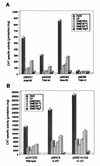Analysis of cis-acting elements required for bfpA expression in enteropathogenic Escherichia coli
- PMID: 9603898
- PMCID: PMC107275
- DOI: 10.1128/JB.180.11.3013-3016.1998
Analysis of cis-acting elements required for bfpA expression in enteropathogenic Escherichia coli
Abstract
bfpA expression in enteropathogenic Escherichia coli is regulated by growth medium, temperature, and ammonium concentration and requires the BfpT protein (also called PerA), a member of the AraC family of transcriptional activators. Site-directed and PCR random mutagenesis, as well as deletion analysis of the bfpA upstream regulatory region, supported assignment of the promoter elements and demonstrated that the cis-acting elements that mediate BfpT-dependent regulation of bfpA are located between positions -85 and -46. Interestingly, this region shares 73% identity with a 40-bp-long AT-rich tract located upstream of the bfpT gene, which is essential for bfpT autoregulation.
Figures





References
-
- Ali S A, Steinkasserer A. PCR-ligation-PCR mutagenesis: a protocol for creating gene fusions and mutations. BioTechniques. 1995;18:746–750. - PubMed
-
- Brosius J. Plasmid vectors for the selection of promoters. Gene. 1984;27:151–160. - PubMed
-
- Cravioto A, Gross R, Scotland S, Rowe B. An adhesive factor found in strains of Escherichia coli belonging to the traditional infantile enteropathogenic serotypes. Curr Microbiol. 1979;3:95–99.
Publication types
MeSH terms
Substances
LinkOut - more resources
Full Text Sources

